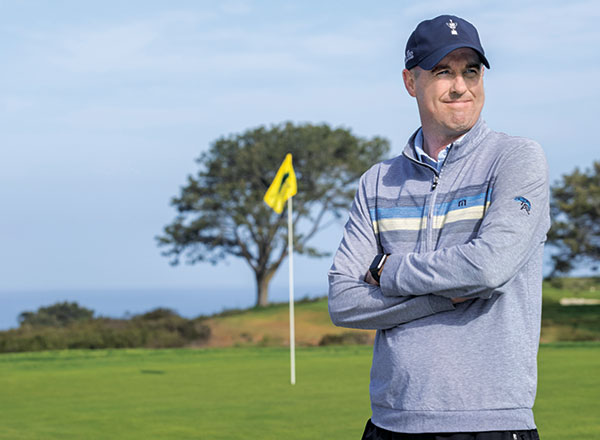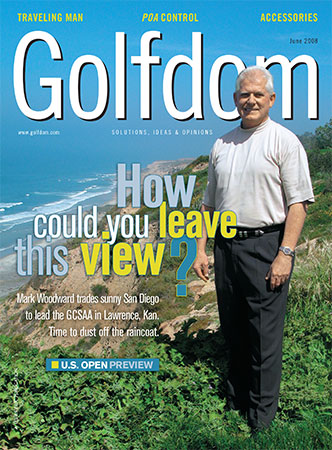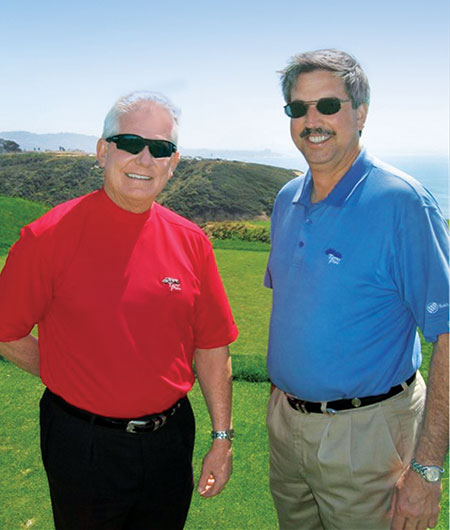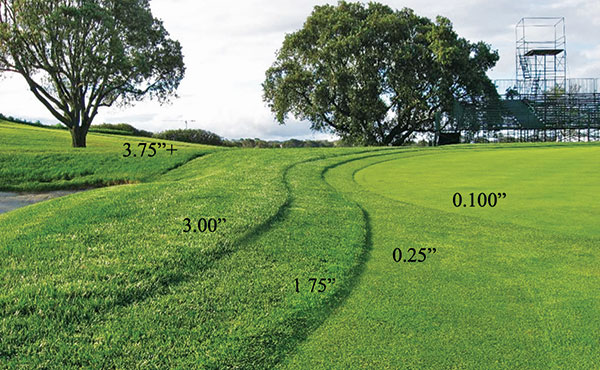A conversation between past and present U.S. Open superintendents

Rich McIntosh (Photo by: Brandon Colbert)
The 2008 U.S. Open at Torrey Pines, pitting Rocco Mediate against Tiger Woods in an 18-hole Monday playoff, remains one of the most exciting U.S. Opens ever. Next month, the U.S. Open returns to San Diego and the site of that legendary tournament.
The man at the helm of course conditions then was Golfdom Contributing Editor Mark Woodward, CGCS. How great would it be to ask Woodward to ring up the course’s current superintendent, Rich McIntosh, to discuss the 2021 U.S. Open?
That’s exactly what we did. Here’s what the one-time and soon-to-be Torrey Pines U.S. Open superintendents talked about.
Mark Woodward: I’ve been thinking about you a lot lately, Rich, because the U.S. Open is coming up. How are you doing?
Rich McIntosh: (As of late April), we’re in a real good position. My biggest problem is trying to be patient. We’re still cold outside. Our rough is still an inch-and-a-half. We’re trying to expose as much kikuyu as possible to get it moving. It’ll be a hodgepodge of rye and kikuyu, but I want it to look as much like a monostand, a uniform mix of kikuyu and ryegrass throughout the property.
Woodward: Will the graduated rough be back?
McIntosh: A little bit, but nowhere near the extent that it was when you were here. Mainly on the par fours, a little bit of graduated rough. Intermediate, primary and secondary — three different heights.
Woodward: How’s your staffing? When I was there, I dealt with two or three unions, and we had 105 volunteers coming in.

Mark Woodward, CGCS, featured on the cover of the June 2008 U.S. Open preview issue. (Photo courtesy of Golfdom archives)
McIntosh: Things haven’t changed, but a lot of the work you did in 2008 helped pave the way. The city knows what is coming. We’re trying to follow the blueprint from the Farmers (Insurance Open) as well as the 2008 U.S. Open. We’re bringing in 70 to 75 volunteers. It’s been difficult with the pandemic; we’ve been short-staffed and under a hiring freeze. If we need to, we can pull from the other city courses.
Woodward: It brings back memories. I tell people it was the best three years of my career and the worst three years of my career. I was trying to write a business plan, I was preparing for the U.S. Open, I was dealing with staffing issues … it was a political nightmare. Along the way, I had my life threatened over golf, I raised fees by $2 …
McIntosh: We’re still hearing about you raising the rates! I don’t think that will ever go away. ‘Back when I used to play, it only cost …’ Well, it’s a different product now, too.
Woodward: Day in and day out, Torrey Pines should get that kind of money because people want to play there; they want to walk in Tiger Woods’ footprints.
McIntosh: And it’s a sustainable business model. We are able to operate on our own with the revenue we generate, and we can put some money away for capital improvement projects, so we can continue to improve the golf course.
Woodward: Are you using the back tees on No. 13?
McIntosh: Oh yeah, we use it for the Farmers. The renovation we did in 2019, mainly for infrastructure and upgrading bunkers, a new irrigation system — just modernizing the golf course for the next 20 years — allowed Rees (Jones) to come in and make some tweaks. We actually put another tee in behind the pro tees on No. 15. It can be a 517-yard par four now.
Woodward: Tell me about the turf types. Are you still primarily Poa annua on the greens?
McIntosh: Poa annua on the South; during the redo of the North in ’16, they did go to bentgrass greens. You know, this is the perfect climate for growing Poa annua greens.
Woodward: Those are temporary bentgrass greens.

Woodward (left) and Jon Maddern, CGCS, teamed up to take on the 2008 U.S. Open conditions. (Photo courtesy of Mark Woodward)
McIntosh: We’re still fighting it. I’ll fight it to the last day I’m here because I’m stubborn. We regrassed tees and approaches, kept them bermuda for consistency and firmness. I went with Latitude 36, a little more tolerance to cool weather. We’ve seen great benefits, and it’s an easier transition than the old 419 was. It’s been a really good grass for us. Still pure kikuyu fairways and kikuyu rough.
Woodward: When I was at Torrey Pines, I told people, ‘I grow three weeds for a living, kikuyugrass, Poa annua and eucalyptus trees.’ There was kikuyugrass in the parking lot growing up through a handicapped parking pole, 8 feet up in the air. And then, we were mowing fairways at a half-inch. The adaptability of that grass is amazing.
McIntosh: It can be the most invasive grass … Pat Gross (retired USGA agronomist) says kikuyugrass is a coward. It’s strong and mighty when it grows where you don’t want it to … then you put it under stress, and it runs away and hides.
Woodward: The trees were a huge issue. We had trees shading greens, 100-foot eucalyptus trees.
McIntosh: A lot of trees have come down in the last 10 years. There were some storms that came through. My first Farmers here, play was suspended on Sunday due to high winds. We had 70- to 90-mile-per-hour sustained winds. I drove out of the shop, there was a euc down there, a euc down there … there were 30 to 40 trees uprooted. That and we’ve been hit really hard by the pine bark beetle. It’s taken a lot of Torreys out. Not just the beetle, but also they’re at the end of their life — they were planted when the course was built. They only live 60 to 70 years.
Woodward: Turf and trees don’t always go together.
McIntosh: Especially eucalyptus trees. It’ll be a perfectly calm day, and you’ll see a 12-, 14-inch diameter limb just drop because the tree decided it was too heavy. You’re right, eucs are a weed.

In 2008, the USGA had four heights of cut of rough. The 2021 rough will be less complex. (Photo courtesy of Mark Woodward)
Woodward: They should be outlawed — that’s just one man’s opinion! I’ve been thinking about you Rich for a long time. When Seth (Jones) set this up, I was excited. I wanted to hear where you’re at and how you’re doing. One of the only U.S. Opens I haven’t watched in my whole life was the 2008 U.S. Open because you’re so busy. Enjoy it. Go out there and see what’s going on. You know how hard your staff worked. Your mentors are coming in. They’re going to see the finished product. Make sure you enjoy it because once it’s over, it’s done. I wish you all the luck in the world.
McIntosh: I’m most excited for all the volunteers coming out, my mentors coming out the week prior and seeing the product … and then all the hard work that our staff has put in, to enjoy tournament week and the results of the hard work. It’s everything we’ve been working toward since I got here.
Rich McIntosh’s path to the 2021 U.S. Open
- Graduate, The Ohio State University
- Muirfield Village GC, Dublin, Ohio
- The Grove GC, Watford, England
- Ocean Reef Club, Key Largo, Fla.
- Torrey Pines, La Jolla, Calif.









